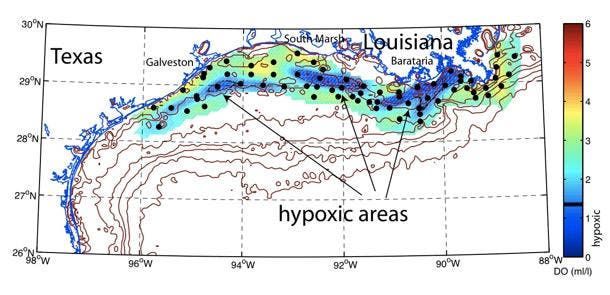Recently, researchers from the Texas A&M University have returned from a trip which had the purpose of estimating the extend of this year’s “dead zone” in the Gulf of Mexico. They have currently measured it to about 3,300 square miles, which is roughly the size of “Rhose Island and Delaware combined”. However, researchers estimate it will continue to grow larger and larger as time passes.
Oceanography professor Steve DiMarco, one of the country’s leading authorities on the dead zone, says they explored the area for five days, traveling over 1400 miles throughout the Gulf; he says that the area off the coast of Louisiana has been closely monitored for the past 25 years, and never before has there been such an increase in the nitrogen level (which are closely related to human activities). What happens is that when the nitrogen levels increase, the oxygen level decreases, and thus hypoxia ensues. Hypoxia can result in the severe death of fish and other marine life, thus creating a so called dead zone.
“This was the first-ever research cruise conducted to specifically target the size of hypoxia in the month of June,” DiMarco says. “We found three distinct hypoxic areas. One was near the Barataria and Terrebonne region off the Louisiana coast, the second was south of Marsh Island (also Louisiana) and the third was off the Galveston coast. We found no hypoxia in the 10 stations we visited east of the Mississippi delta.”
DiMarco says he will be keeping a close eye on the area, in an attempt to estimate the growth of the dead zone, as well as possibly find some solutions about what could be done.
“The largest areas of hypoxia are still around the Louisiana coast, where you would expect them because of the huge amounts of fresh water still coming down from the Mississippi River,” he adds. “The hypoxic area extends about 50 miles off the coast. The farther you go west toward Texas, there is still hypoxia, but less severe. However, we did see noticeable hypoxia near the Galveston area.”










